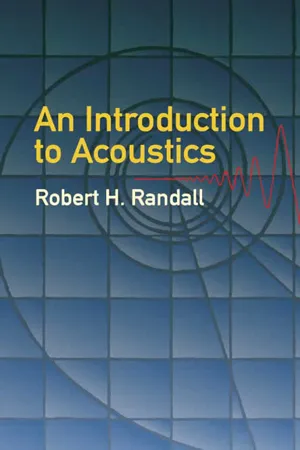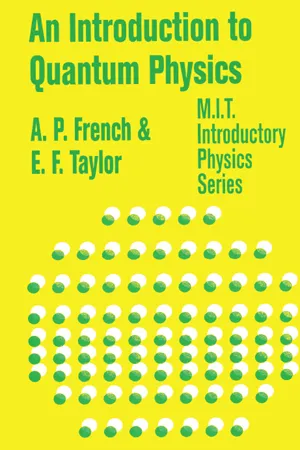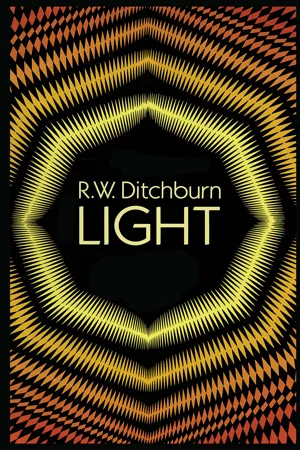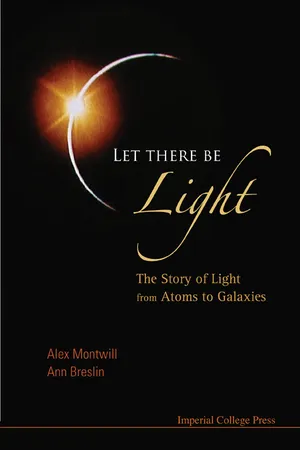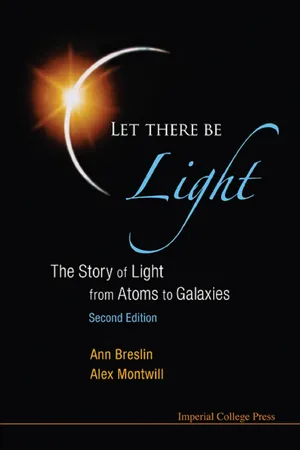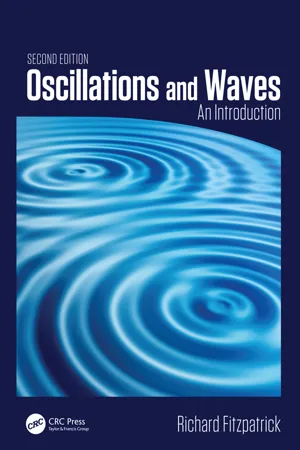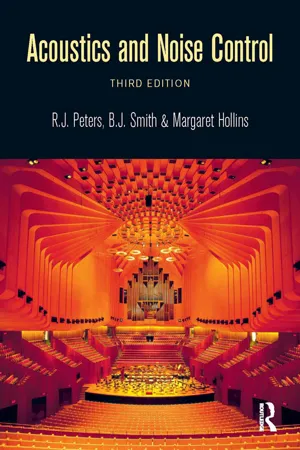Physics
Stationary Waves
Stationary waves, also known as standing waves, are formed by the interference of two waves traveling in opposite directions. In a stationary wave, certain points called nodes remain stationary while other points called antinodes oscillate with maximum amplitude. These waves are commonly observed in musical instruments, such as strings and pipes, and have applications in various fields including acoustics and optics.
Written by Perlego with AI-assistance
Related key terms
Related key terms
1 of 4
Related key terms
1 of 3
8 Key excerpts on "Stationary Waves"
- eBook - ePub
- Robert H. Randall(Author)
- 2012(Publication Date)
- Dover Publications(Publisher)
CHAPTER 7Stationary Waves. VIBRATING SOURCES. MUSICAL INSTRUMENTS
7–1 Introduction
. The fundamental relations for plane and for spherical waves developed in Chapters 2 and 3 have assumed that a disturbance, once set up, travels out from the source an indefinite distance. This picture of a medium infinite in extent is useful for any fundamental description of the physics of wave propagation since, at any one point in space, we are concerned with waves traveling in one direction only. For sound sources radiating into the open air, and with few obstacles to reflect or scatter the energy, the medium may be considered virtually infinite in extent. However, when sound waves strike hard, relatively rigid structures, an appreciable fraction of the incident energy may be deflected and perhaps returned in the direction of the source. In the region where this occurs there will be two wave trains moving in opposite directions, each contributing to the deformation of the medium.Under certain conditions this situation may give rise to stationary or standing waves, with a whole new set of features quite foreign to waves of the unidirectional type. In this case the “pattern” of the deformation in the medium remains fixed in space, with no evidence at all of propagating crests or troughs. It is with this general phenomenon that we shall be mainly concerned in this chapter.Stationary Waves may occur in any medium having definite boundaries. In air, such waves may be of primary importance within a room, where the medium is confined by the surrounding walls. Wave reflection, and the consequent production of a standing wave pattern, may sometimes take place without an actual change of medium. This is the case when waves traveling down a cylindrical pipe reach an end open to the surrounding air. In this case the reflection is associated with the change in the acoustic impedance as the wave passes from the region within the pipe to the region of free space beyond it. This phenomenon is very similar to that taking place in an electrical transmission line whenever the line characteristics change abruptly and we shall have more to say about it later. - eBook - ePub
- A.P. French(Author)
- 2018(Publication Date)
- Routledge(Publisher)
linearity, so that if Ψ1 and Ψ2 are specific solutions to one of these equations, then any linear combination of them is a solution of the same equation. This property of superposition is one of the most basic properties of waves.2. Their solutions are (as we shall see in Chapter 9 ), perfectly suited to the interpretation of Ψ as a probability amplitude.Finally, there is all the accumulated evidence that the Schrödinger equations work; they provide the basis for a correct analysis of all kinds of molecular, atomic, and nuclear systems. Whatever questionable features there may be in the manner of their formulation are swept away in the evidence of their manifest success—a success of which we shall see many examples in this book.3.4 STATIONARY STATESIn the present chapter our chief goal will be to learn how to calculate the energies of particles bound within certain regions of space, as, for example, the electron in a hydrogen atom. We have seen that the allowed energies of such states—exemplified by the stationary states of Bohr’s theory—are quantized. In contrast to a free particle, a bound particle is limited to energies belonging to a set of discrete values, even though, as in the hydrogen atom, these energy states may be infinite in number. The theoretical basis for the existence of states of discrete energies emerges more or less directly from the wave-particle duality; one of the most familiar features of classical wave behavior is that of standing waves. The free vibrations of any physical system of finite dimensions—a violin string, an organ pipe, a microwave cavity—are limited to a set of characteristic frequencies. Each such frequency belongs to what is called a normal mode - eBook - ePub
- A. L. Stanford, J. M. Tanner(Authors)
- 2014(Publication Date)
- Academic Press(Publisher)
destructive interference . And again, as in constructive interference, after they coincide each wave proceeds as if it had not encountered the other.Figure 19.10 (a ) Two wave pulses of equal amplitudes meeting and interfering constructively. (b ) Two waves of equal amplitudes meeting and interfering destructively.Standing waves are produced when harmonic waves of equal frequencies and amplitudes travel in opposite directions in the same medium. The displacements of particles in the medium then form a standing-wave pattern (a pattern that does not propagate through the medium). Such standing waves are commonly seen in the vibrations of the strings of musical instruments, like guitars or violins. We may illustrate the analysis of standing waves by considering a similar situation: a taut string fixed at both ends, as shown in Figure 19.11 .Figure 19.11 A taut string, fixed at each end, vibrating in its three longest wavelength modes.Because the ends of the string are fixed, the end points of the string are nodes , points of the medium where the displacement is always equal to zero. Points on the string midway between nodes are called antinodes . The various forms of standing waves, three of which are shown in Figure 19.11 , that are compatible with the boundary conditions (each end of the string is a node) are called the natural modes of vibration. The mode having the fewest number of nodes is called the fundamental mode . As we will demonstrate later, the distance between adjacent nodes is equal to λ/2, where λ is the wavelength of the two traveling waves that form the standing wave. Thus if L is the length of the string in Figure 19.11 , the wavelength λ1 , associated with the fundamental mode, is equal to 2L , as indicated in Figure 19.11(a) . Generalizing from Figure 19.11 , we may conclude that the wavelength λn associated with the n - eBook - ePub
- R. W. Ditchburn(Author)
- 2013(Publication Date)
- Dover Publications(Publisher)
κ = λ/4 and the distance between successive nodes is λ/2.Fig. 3.10.—Distrubution of energy in a medium in which there is a simple stationary waveNow consider the case when the reflection is not perfect. The coefficient of reflection (ρ) is defined to be the ratio of the energy of the reflected beam to the energy of the incident beam. This implies that the ratio of the amplitudes is ρ .Equation 3(41) must now be replaced byand 3(43) is replaced byThe wave is now partly stationary and partly progressive. A detector moved along the x axis will still record maxima and minima. The readings at minima will not be zero since at points where the first term of 3(45) is zero the detector gives a reading proportional to the square of the amplitude of the second term. Waves which are mainly stationary, though containing a progressive component, occur commonly in acoustics in connection with the theory of organ pipes, etc. A series of observations made by Walton on stationary electromagnetic waves is shown in fig. 3.11 . These waves are produced by allowing radiation emitted by a small high-frequency oscillator to fall upon a large sheet of metal placed at x = 0. The waves are measured by means of a small crystal detector connected to an amplifier. The metal has a high coefficient of reflection for these waves and the waves are mainly Stationary Waves with a small progressive component. From the distance between the nodes the wavelength is found to be 11.6 centimetres.Fig. 3.11.—Experimental observations on stationary electromagnetic waves 3.22. Wiener’s Experiment.The detection of stationary light waves is difficult because the nodes and antinodes are very close together, the distance from node to antinode being only of order 10−5 centimetre. The experimental difficulties were first overcome by Wiener (1890). Before discussing his work we shall describe the experiments of Ives which though more difficult to carry out are theoretically simpler. Ives prepared special photographic plates with a thin fine-grained emulsion. The emulsion side of the plate was placed in contact with a film of mercury and a parallel beam of monochromatic light was directed normally upon the glass side of the plate (see fig. 3.12 ). The light passed through the glass and the film and was reflected at the mercury surface, standing waves being formed in the film. The nodes form a series of laminae distant - eBook - ePub
Let There Be Light
The Story of Light from Atoms to Galaxies
- Alex Montwill, Ann Breslin(Authors)
- 2008(Publication Date)
- ICP(Publisher)
Figure 6.7 . The dots show successive positions of string particles at equal intervals of time, indicated by the different shades. Particles situated at antinodes such as A vibrate with maximal amplitude and those at nodes such as B do not vibrate at all. The contemporaneous positions of adjacent particles lie on curves of the same shade. The unique feature of standing waves is that energy is not transmitted but stored as vibrational energy of the particles.A standing wave stores energy in the oscillations of the particles disturbed by the two waves.Figure 6.7 Time sequence of the positions of the particles of a vibrating string.(In practice, there is no such a thing as a completely rigid support and a small amount of energy will ‘escape’ from the string at each reflection.)6.4.5 Standing wavesA string of fixed length has a number of normal modes of vibration corresponding to exact numbers of half wavelengths which ‘fit exactly’ into that length of string. The amplitude of vibration must be zero at both ends of the string.The normal modes of a vibrating string.The frequencies of the normal modes are called the natural frequencies (fn ) of the string, andA mathematical treatment can be found in Appendix 6.3 . It does not give any more physical insight, but it does make a very clear distinction between travelling and standing waves and allows us to calculate the position of any particle at any time.6.5 Forced oscillations and resonanceWe can use an oscillator to produce waves on a string or in other materials, such as air. If the string or other system has natural frequencies of vibration, its subsequent behaviour depends on whether the frequency of the oscillator matches one of these frequencies.6.5.1 Forced oscillationsSuppose that an oscillator drives a string to vibrate. The wave will be directed down the string and reflected at the far end, which is a node because it is fixed. As the incoming and reflected waves meet, nodes separated by distances of λ/2 will be formed. The reflected wave returns to the oscillator end, which is also a node (assuming the amplitude of the waves generated by the oscillator to be small). In Figure 6.8 - eBook - ePub
Let There Be Light
The Story of Light from Atoms to Galaxies
- Ann Breslin, Alex Montwill(Authors)
- 2013(Publication Date)
- ICP(Publisher)
all the particles oscillate in phase at the frequency of the wave, as illustrated on the next page. The dots show successive positions of string particles at equal intervals of time, indicated by the different shades. Particles situated at antinodes such as A vibrate with maximal amplitude, and those at nodes such as B do not vibrate at all. The contemporaneous positions of adjacent particles lie on curves of the same shade. The unique feature of standing waves is that energy is not transmitted but stored as vibrational energy of the particles.(In practice, there is no such thing as a completely rigid support and a small amount of energy will ‘escape’ from the string at each reflection.)A standing wave stores energy in the oscillations of the particles disturbed by the two waves.A string of fixed length has a number of normal modes of vibration corresponding to whole numbers of half wavelengths which ‘fit exactly’ into that length of string. The amplitude of vibration must be zero at both ends of the string.The first harmonic (lowest frequency mode) of a string of length L is produced when just one half wavelength ‘fits’ on the string. The second and third harmonics correspond to two and three half wavelengths respectively, as shown in the figure below.Wavespeed = frequency × wavelength = constant, so if the wavelength gets smaller the frequency increases accordingly.The frequencies of the harmonics (or normal modes) are called the natural frequencies of the string.Natural frequencies of a vibrating string.A fuller mathematical treatment does not give any more physical insight, but it does make a very clear distinction between travelling and standing waves and allows us to calculate the position of any particle at any time.6.4 Forced oscillations and resonanceWe can use an oscillator to produce waves on a string or in other materials, such as air. If the string or other system has natural frequencies of vibration, its subsequent behaviour depends on whether the frequency of the oscillator matches one of these frequencies. - eBook - ePub
Oscillations and Waves
An Introduction, Second Edition
- Richard Fitzpatrick(Author)
- 2018(Publication Date)
- CRC Press(Publisher)
standing wave of the general formψ(6.2)(=x , t)[cosA cos](+ B sink x)(k x)(.ω t − ϕ)The associated nodes are located at the values of x that satisfyA cos(6.3)(+ B sink x)(= 0 ,k x)which implies that they are stationary, and also evenly spaced a distance λ/2 apart, where λ = 2π/k is the wavelength. Moreover, the anti-nodes are situated halfway between the nodes. For example, suppose that both boundaries of the medium are fixed. It follows that the points x = 0 and x = l must each correspond to a node. This is only possible if the length of the medium, l, is a half-integer number of wavelengths; that is, l = n λ/2, where n is a positive integer. We conclude that, in this case, the possible wavenumbers of standing wave solutions to the wave equation are quantized such thatMoreover, the same is true if both boundaries are free. Finally, if one boundary is free, and the other fixed, then the quantization of wavenumbers takes the slightly different formk l = n π .(6.4)k l =(6.5)(π .n − 1 / 2)Those standing wave solutions that satisfy the appropriate quantization criterion are known as the normal modes of the system. (See Chapter 3 .) Moreover, substitution of Equation (6.2) into the wave equation, (6.1) , yields the standing wave dispersion relationω = k υ .(6.6)The fact that normal mode wavenumbers are quantized immediately implies that the associated oscillation frequencies are also quantized. Finally, because the wave equation is linear, the most general solution that satisfies the boundary conditions is a linear superposition of all of the normal modes. Such a solution has the appropriate node or anti-node at each of the boundaries, but does not necessarily have any stationary nodes or anti-nodes in the interior of the medium. - eBook - ePub
- R J Peters(Author)
- 2013(Publication Date)
- Routledge(Publisher)
B =f 1-f 2Beats can occur between different notes in some musical compositions and are used in the tuning of musical instruments. They may also be produced by rotating machines such as fans or motors which produce tones related to their rotation speed. If there are two such machines, nominally identical and rotating at the same speeds, beats can occur if in practice the two machines are running at slightly different speeds.One-dimensional standing waves
Standing waves in strings, pipes and rods are important in the operation of many musical instruments.Standing waves in strings
The simplest case to consider is that of a string stretched between two fixed ends (see Figure 1.20 ). When a wave is created in the string it vibrates between the ends as a result of reflection. Interference will occur continuously between the waves travelling in the opposite directions, and in general these patterns of interference will be continually changing. But there are certain special frequencies at which steady, or standing, waves are set up. The lowest frequency, called the fundamental, or first harmonic, occurs at the frequency at which the length of the string is equal to one half of a wavelength. Under these circumstance every point on the string is vibrating in phase, but the amplitude increases from zero at the ends to a maximum in the middle. This is also called the first mode of vibration of the string, and, like every other mode, is characterized by its frequency and also by its mode shape which describes the shape of the vibrating string. (Note that you may also come across the alternative terms eigenfunction (mode shape) and eigen-frequency (mode frequency) in technical literature.)Figure 1.20 Mode shapes of standing waves in stringsThe next mode of vibration occurs at a frequency for which the wavelength in the string will be one wavelength (or two half wavelengths). The mode shape for this mode contains two maxima (or antinodes) ¼ and ¾ along the length of the string, and three minima, or nodes, one at each end and one in the middle. The frequency of this mode, called the second harmonic, is twice that of that of the first mode.
Index pages curate the most relevant extracts from our library of academic textbooks. They’ve been created using an in-house natural language model (NLM), each adding context and meaning to key research topics.
Explore more topic indexes
Explore more topic indexes
1 of 6
Explore more topic indexes
1 of 4
